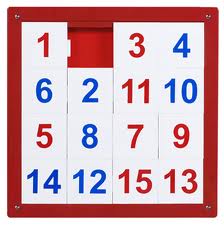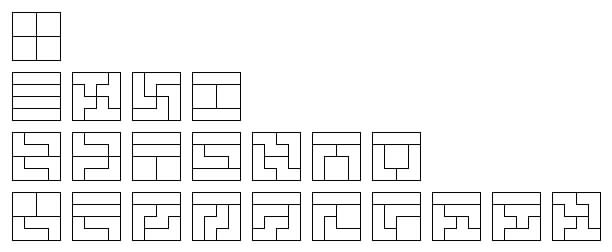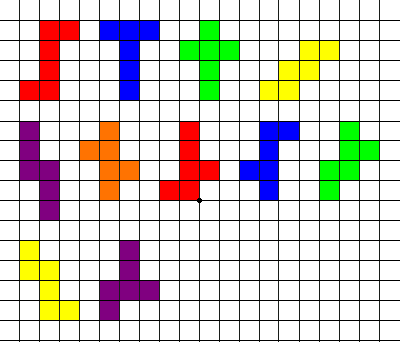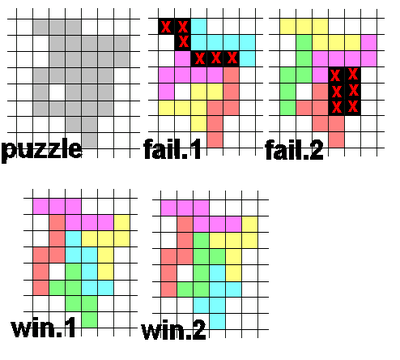Puzzle Design & Reading Failure
 Wednesday, August 18, 2010 at 2:30PM
Wednesday, August 18, 2010 at 2:30PM Working with Mega Man 10 and taking a closer look at the process of trial and error, I've been thinking about analyze.knowledge skills. Typically when you conduct a trial/experiment and it fails, you analyze how and why you failed to build game knowledge and form better strategies. For a game like Mega Man 10, each level is composed of many challenges. Every screen can contain any where from 0 to 4+ challenges. And all the challenges of a level are connected mainly because they're arranged in that order. But puzzle games are different. Or, at least some puzzle games are different. Bending the rules and the relationship between trials and errors, some puzzle games are designed without a fail state. Simply by manipulating a few elements according to a handful of game rules, players attempt to solve knowledge stressing puzzle challenges. Because such puzzle games are designed so uniquely, players can gain significantly more key information for solving the puzzle challenge by analyzing their mistakes than with challenges of other gaming genre.

Remember these old panel slide puzzle games? I remember solving my first one when I was a little kid (about 6 years old). I loved getting one square from one side of the puzzle to the other without disturbing the order of the other panels. To do so, I had to rotate the squares around in small repeating sequences. The process was oddly familiar and soothing like repeating a verse in a song or solving a math problem but with physical motions. (It's no wonder that puzzle games are one of my favorite gaming genre and that I aspire to become a video game puzzle master).
One feature I discovered that also resonated with me is that I could never break the slide puzzle. As long as I didn't pop out any of the squares and/or lose them, I could always find my way back to the solution. In fact, though I was young I was beginning to understand that slide puzzles have the following features:
- no fail state
- repeating sequences of motions to execute a simple translation
- algorithmic solvability
Puzzles with some or all of these features allow us to do something very unique when solving them. Instead of simply trying a move or a combination, failing, and trying another combination (repeating this process until a solution is reached), you can read any of your non-solutions to give you significant insight to the real solution(s). And by "read," I refer to the process of using a thorough understanding of the game rules, elements, and dynamics to reverse engineer the perceived solution while simultaneously eliminating erroneous options. Read more about puzzle game reading and design here.
By reading non-solutions, or failed attempts to solve certain puzzles, it's possible to cut down on the trial and error. This double layered reading is like seeing more angles of a 3D structure while traditional trial and error is more like guessing your friends favorite fruit/vegetable and only receiving yes/no answers as feedback. Of course reading puzzles and reading non-solutions takes more knowledge skills than simple trial and error. Specifically analyze.knowledge skills, which is fairly high on blooms list of cognitive learning.
So now the question is what video games feature this double layered reading. Here's a quick list:
- Tetris DS Puzzle Mode
- BOXLIFE
- Hexiom
- Endice
- Base 10
- Layton 2 Pancake Stacks & Hanoi Puzzles
- Zengage (some levels)
- Link 'N' Launch
Let's look at BOXLIFE and Tetris.

Tetrominos (tetris pieces) allow multiple ways to reach the goal (creating solid lines of 10) because they can be rotated and fit together in hundreds of combinations. For a single row, a piece can contribute 1-4 blocks depending on the arrangement. At the same time, a single piece can affect 1-4 rows. Basically, playing Tetris involves constantly "counting to 10" with multiple rows. Just understanding the game this way allows us to see how algorithmic this process can be. Throw in random pieces and it's obvious that a player with a thorough understanding of how every piece potentially fits into any combination is the primary skill.

The core gameplay of BOXLIFE revolves around cutting 6 sided boxes out of a flat piece of paper. There are a total of 11 different ways this can be done. So when presented with large pieces of paper where multiple boxes must be cut out, the challenge comes from finding a right combination of cube cutouts that will use up every inch of paper. As with all good puzzle games, there are more ways to be wrong than right.
Like tetrominos, the skill in BOXLIFE requires players to thoroughly understand how the different box shapes fit together and how changing one box shape creates a ripple effect possibly requiring all of your other box cutout shapes to change. In BOXLIFE's puzzle mode every box shape you cut out in BOXLIFE consumes the available paper. This affects the next shapes you can cut out.
So whenever I produce a non-solution in either game, I study the game state. If you think about it, with double layered puzzle game challenges, working out a non-solution is essentially like creating a different version of the same puzzle. Some of the pieces may be in the wrong places or your non-solution may barely be off the mark, but all of this directly reflects the original problem. Seeing things from this new angle should point you in the right direction if your knowledge skills are good enough.
Look at the puzzle marked in the image above. I have to take this shape and cut it up perfectly into cubes. If I reach any of the fail combinations, instead of hitting the reset button, I can read the non-solutions. "Fail.1" shows me where the trickiest/strictest section of the puzzle is and what happens when I don't address this area first. For this puzzle, the hardest section to work with is the left side mainly because of the 1 square hole. If I leave this to the end, the result will most likely be disconnected. Let's say I make a quick adjustment, and everything shifts into what we have in fail.2. Now the trouble spot is a solid shape, but it's not a shape that can be folded into a cube. This is a step closer to victory than fail.1. To break up the problem area in fail.2, I stab into the shape resulting in the yellow shape seen in win.1/win.2. Simply going with the flow from the fix in fail.2 creates win.1. Win.2 is a possibility that can be reached from fail.2 that's a little less efficient and therefore a bit more unconventional/creative.
Double layered reading is a quality of deep puzzle challenges as opposed to complex puzzle challenges. Complex challenges generally challenge players to absorb and organize lots of information with minimal analyzation. Deep puzzle games challenge players to consider a very small set of information/rules and consider the many ways they interact and create permutations. It's all about playing smarter not harder.
I'll completely understand if you're a bit confused and you have to give this post another reading.



Reader Comments (1)
In recent years, one of the Sudoku puzzle games has been the most popular. It's the perfect game for anyone who likes working with numbers. Just be prepared to spend a lot of playing time, because once you start, you do not want to stop. There are plenty of puzzles for each level, therefore, the challenge seems to last forever. A more traditional type of puzzle that can also be seen as a game is a puzzle.